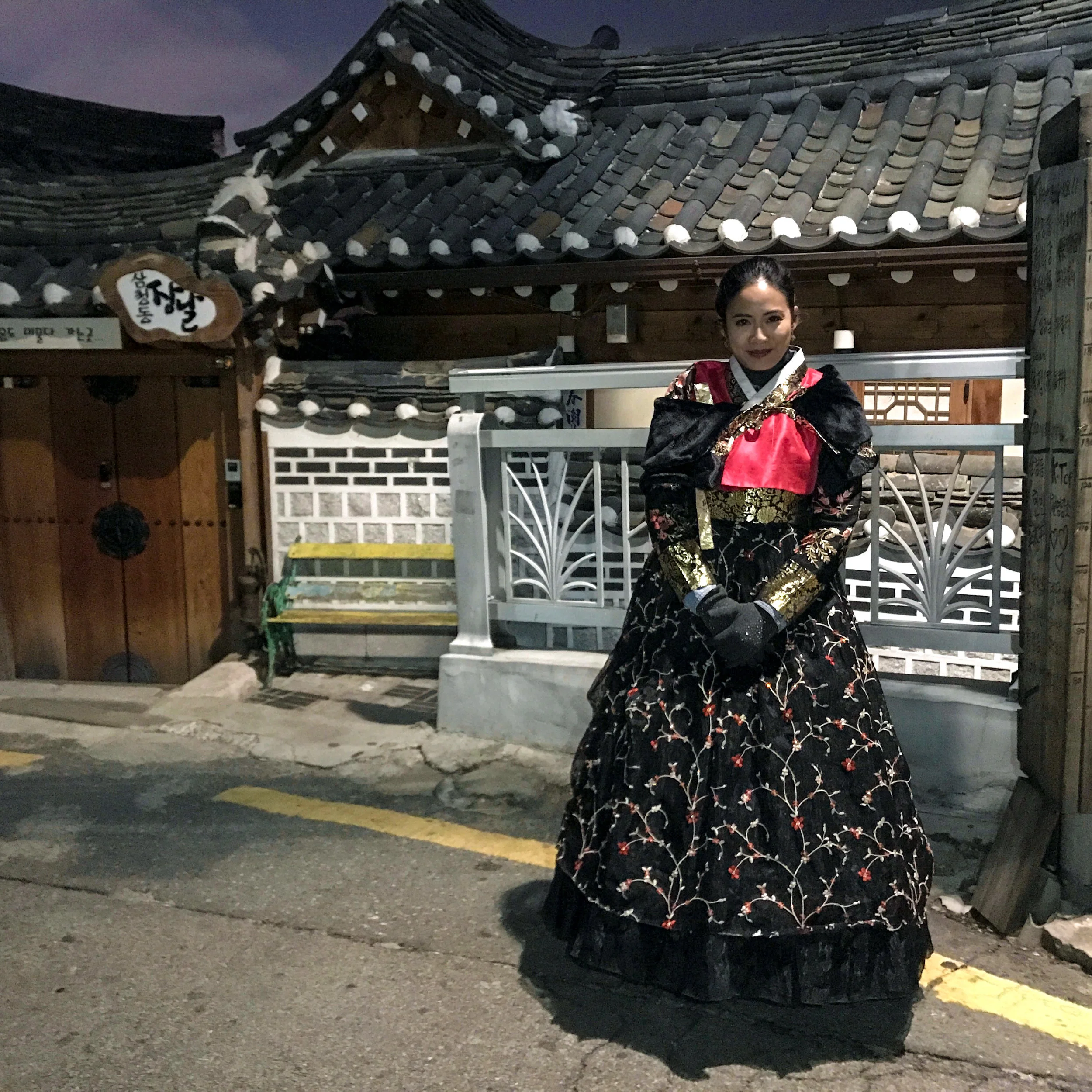TOURING SEOUL: Hanboks
Wearing a traditional royal Hanbok in Bukchon Hanok Village.
Dear Foodie Fam,
This is my T-Money card which I used for Seoul public transit. South Korean Naver Corporation’s Line Friends are on it dressed in handboks!
Let me tell you about one of the coolest things I learned about in South Korea- the hanbok!
Hanbok History
The hanbok is a form of traditional South Korean clothing (and the world literally means that, too.) It’s been worn since the early 1400s.
Yes, hanboks are worn at festivals, celebrations, and ceremonies. Kids even wear the hanbok on their first birthday and adults wear them for weddings and at funerals… However, hanboks are also worn for everyday use. More and more Koreans are embracing types of hanboks adapted to daily wear. The South Korean government encourages the embrace of the hanbok through National Hanbok day amongst other celebrations and ceremonies.
South Koreans have shops all over traditional villages like Bukchon Hanok where they educate you about their culture through the hanbok. They help you pick out a set to wear, teach you how to wear it, and talk about what sort you are wearing. You can even get your hair done or borrow accessories like stoles and hats.
Hanboks Symbology
Hanboks spoke about more than beauty. The colors of hanboks are based on the ying yang theory: red stands for fire, black for water and so on. Colors also spoke statements about age, class, marital status, profession, seasons and even motherhood. Embroidered flowers or creatures also had meanings.
My outfit had black, red and gold elements. Here’s what the colors traditionally meant:
Red: fortune
Black: infinity
Gold: reserved for royalty.
Embroidered images also had meanings:
Peonies: wedding wishes for honor and wealth.
Lotus flowers: hope for nobility,
Bats/pomegranates: desire for children.
Dragons, phoenixes, cranes, tigers: royalty and high-ranking officials.
BEFORE!
AFTER!
I picked an ensemble heavily embroidered with lots of layers and texture. My chima 치마 (skirt) had a gorgeous sheen under thin, sheer embroidered layers. I also wore a faux fur stole to help keep me warm but because I could wear my regular clothes under all this, I did stay very snug.
Since I was going all out, I did opt in for my hair to get done. It was pulled back into a fishtail braid with pearly pins in it (I don’t think this was a traditional hairstyle- it was just for dress up funsies.) Dutch kept staring at it! He picked out a hat for his own outfit.
How to wear Hanboks:
1) If you are a girl, you are probably not wearing baji (pants). The first thing you do is wear the undergarment skirt before wearing the chima. If you are cold like me, depending what kind of chima you are wearing, you have enough room to wear your regular clothes under the Hanbok, too.
2) Wear the full dress (chima 치마) on top of your undergarment. It’s like an empire-waisted skirt that sits high- as in the center of your chest. It starts from where your neckline might be down to your feet.
3) Fit and secure the chima around your waist by tying the ribbons on the skirt.
4) The top (jeogori 저고리) is ornate and short. You layer it over the dress and you tie it in front.
5) You can wear a vest on top of that to complete the look.
By renting this hanbok, I learned just how beautiful these garments are! I felt so grand just strolling in it! I felt like I was silently, smoothly gliding because you couldn’t see my legs or feet. The sensation was heightened because my chima didn’t even touch my legs or the ground due to the light hoop that kept it up. Without looking down, I could have just felt like I was in my pants, only. Dutch also loved the way his baji and long jeogori moved and glinted.
Though stiffer than other material, my hanbok garments were very soft to touch. The sleek lines looked wonderful when they were swishing or floating about.
You can rent these at Bukchon Hanok and even wear them around at the palace nearby if you seriously want to do the most! It’s like $5 to rent these for an hour. We loved wearing ours. Just don’t get them dirty!
…Also, one of my favorite compliments of all time happened… a few Japanese girls (I’m guessing exchange students) took our photo and called me “kawaii!”













